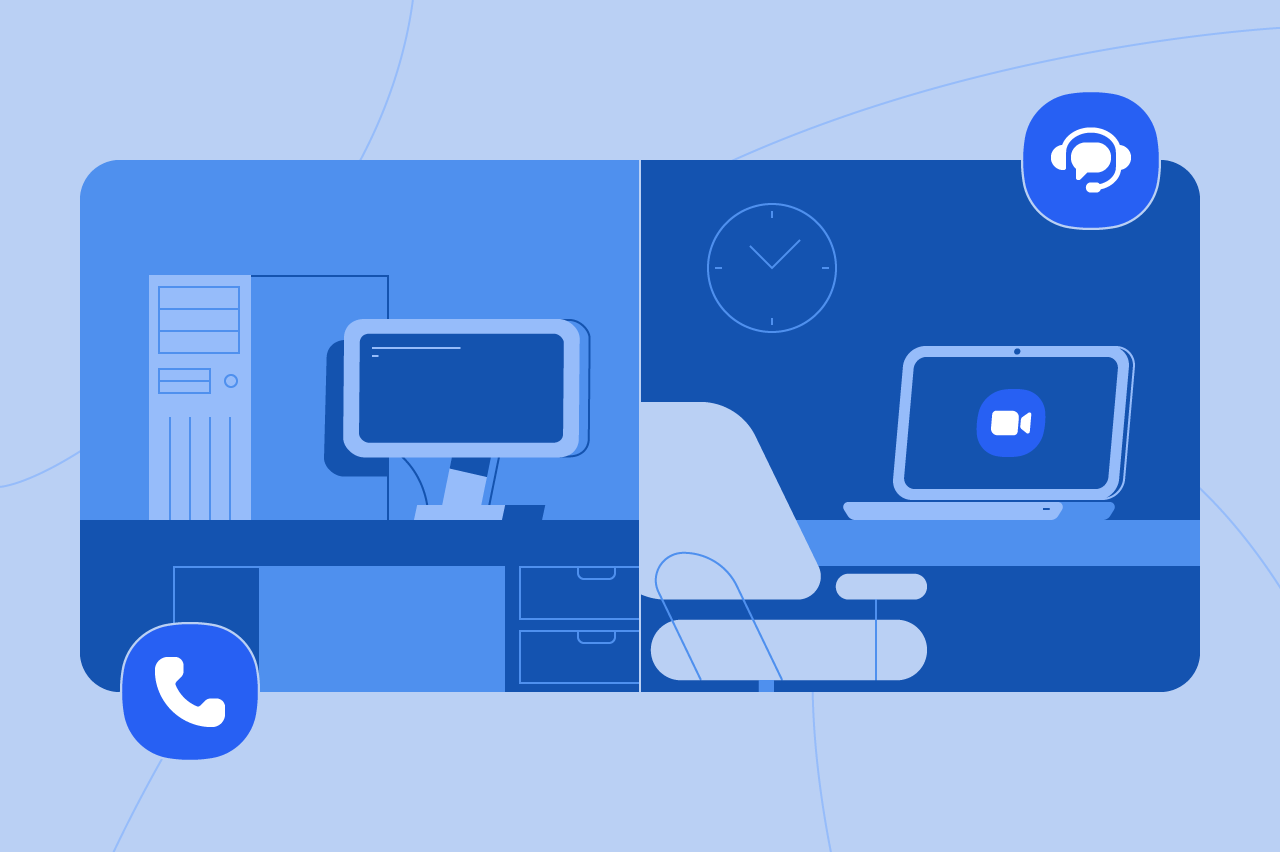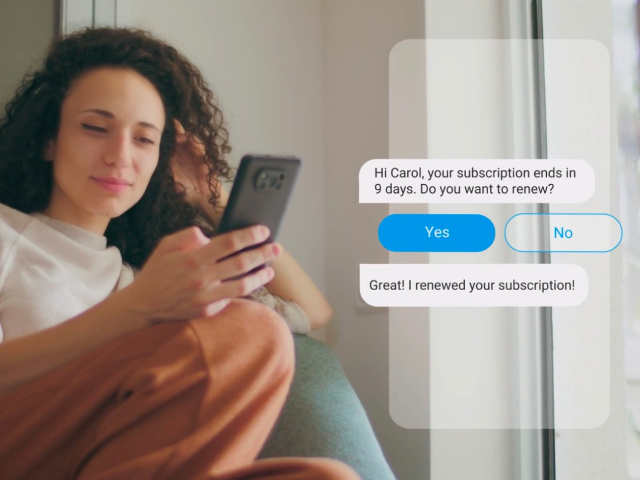
What is a cloud contact center and how to choose the best one
Explore what a cloud contact center is and how it's different from traditional contact center solutions. Explore features and tips to choose the right software.
Updated on February 13, 2025
Published on September 07, 2023


When you consider the advantages of a chatbot for your organization, it’s easy to understand why so many companies are planning chatbot implementations. Not only do they free up resources for support teams – which can help contact center agents avoid burnout – but they provide 24/7 customer service, so customers can self-serve on their own terms. This fast and accurate customer support may just be the thing that sets you apart from the competition.
We’ve outlined some steps below to help you experience a smooth chatbot implementation and increase customer satisfaction.

Besides being one of the most sought-after technologies, chatbots are powerful tools that keep getting better. Keep reading to find out all about the benefits of chatbots below.
One of the most significant advantages of a chatbot is its ability to enhance customer experiences. A chatbot gives your customers a self-service option that allows them near-instant access to the answers, links, web forms, or other information they need.
Chatbots can field numerous requests at once and provide 24/7 service, so there’s less waiting. In addition, customers receive accurate, consistent responses from your knowledge base, help center, or other approved data source.
Many calls to your customer service department are requests for basic information or help with simple tasks. Some customers may want to check on business hours, track a shipment, or change a password. A chatbot can handle many of these customer support issues independently, decreasing the number of tickets your agents need to resolve.
Not only does this efficiency increase customer satisfaction, but it can also reduce customer service costs. (Here's how we use our own chatbot at Zoom to save $13 million per month and experience a 93% self-service rate)
After a chatbot implementation, organizations can better manage the number of agents needed during peak seasons and ticket spikes. Furthermore, chatbots help agents do their jobs better by allowing them to focus on more complex issues and build strong customer relationships.
Businesses with processes that include sending internal or external messaging or taking other actions in response to customer support calls can automate them with a chatbot, or virtual agent. A chatbot can collect necessary information and respond automatically, schedule appointments, trigger a survey or customer feedback request, or take other actions without help from live agents.
The demand for customer support can vary from month to month. Businesses that depend solely on human agents must adapt by adding employees to a shift schedule or they fail to meet customer expectations for fast service. On the other hand, when there’s less demand on the customer support team, employees may get fewer hours than usual or face layoffs.
Chatbot implementation allows a business to deliver successful customer experiences even when the number of tickets increases, and they allow companies to scale back with minimal impact on employee schedules.
Enabling digital customer engagements via chatbots allows businesses to collect more data about customer behaviors. Chatbot platform data can quickly show common issues customers research, which could indicate a product or service issue you need to address.
Collecting that information on a call can slow down customer support agents. However, you can automate data collection with the right chatbot platform.

Like all technology deployments for your business, chatbot implementation begins with systematic planning and strategy. Follow these steps to help create a successful project.
The first step is deciding who will take responsibility for your chatbot implementation project. It may start with one employee who sees the value of adding a chatbot to your customer service department’s capabilities.
However, a successful chatbot project will also have senior-level support, a subject matter expert from your customer service team, and a team from your chatbot platform provider. Large enterprises may also need to build a change management team to help transition to the new technology.
Although chatbots have the potential to provide your organization with several advantages, you still need to decide on the results you want from your chatbot implementation.
What are the primary outcomes you’re looking for from your chatbot implementation? For example, do you need your chatbot to help you:
Your team will use these goals to make decisions that will guide successful chatbot implementation.
The next step is determining how your customers and team will use the chatbot and develop conversation flows. Think through what customers will ask the chatbot to help them with and create the most efficient — and customer-pleasing way — to provide the information needed.
Take advantage of your customer support agents’ experience with this step. They can shed light on how conversations go and the types of responses that lead to customer satisfaction.

A pivotal decision is finding the right type of chatbot you’ll use. You can choose from several chatbot technologies depending on your business goals. Consider the features of these types of chatbots when selecting the best one for your business.
The first two categories of chatbots are similar in the types of information they provide. However, they differ primarily in how people interact with them.
With text-based chatbots, users communicate by text or messaging, creating a quick and efficient way for people to get answers or provide feedback. You can also easily integrate text-based chatbots with SMS, email, and social media.
Voice-activated chatbots allow users to communicate by speaking. The chatbot may respond with a “spoken” reply or a text answer.
In addition to how people interact with them, chatbot platforms can greatly differ in how they work. Rules-based chatbots provide appropriate responses when people use predefined words or phrases or follow set steps.
On the other hand, AI and machine learning (ML) enable a chatbot to “think” like humans. As a result, people don’t have to query artificial intelligence chatbots in certain ways. Instead, the chatbot interprets the intent behind what each customer is asking or requesting, no matter how they phrase their requests.
Various forms of NLP can make interacting with a chatbot much like human conversation. Chatbots leveraging this technology understand human communication, both in its literal interpretation and the user’s intent. The chatbot can train to communicate with its target audience in multiple languages.
A conversational AI chatbot, such as Zoom Virtual Agent, allows you to use customer data to create personalized customer journeys and provide quick, accurate, and intelligent hand-offs to agents.
When you choose chatbot technology to implement for your business, consider your organization’s future needs and how the platform can help you meet your goals today. Chatbot technology is advancing quickly, and consumers are increasingly pleased with their experience of using them. You’ll want to choose technology that allows you to get the most value for your investment.
How you build your chatbot will depend on the type you choose. However, you’ll need a developer that’s an expert in your chatbot platform to build one that enables successful conversations with customers and good bot metrics.

Generally, the developer working on your project will program the chatbot to respond appropriately. Rules-based platforms require programming for the chatbot to respond based on the rules you establish and the answers it can find in your knowledge base or other databases. A machine learning-based chatbot will require training with a dataset and testing to provide relevant responses.
The developer on your project will also program the chatbot to collect and store information you can analyze for insights into customer support and other areas of your business.
Chatbot implementation time is different for each company; however, most teams complete them in about a week. More complicated enterprise implementations can take longer, often up to a month.
A crucial part of your chatbot strategy is combining it with the digital channels that your customers interact with, for example, social media or messenger apps. This integration will provide people with easy access to customer service or support information without searching for a link on the web, opening a different screen, or resorting to phone calls.
Before you launch your chatbot and make it available to your customers, you must test it to make sure it works the way you intend and provides the level of customer service associated with your brand.
Work with your chatbot platform’s implementation team to check for bugs and conflicts with integrations and rely on your team to test the chatbot with typical questions and requests to make sure it provides accurate, relevant responses.
An experienced chatbot platform provider will advise you that the project isn’t over after you launch. You’ll need to evaluate how the chatbot performs and make any necessary adjustments based on employee or customer feedback. Consider setting up 30-, 60-, and 90-day benchmarks to assess and optimize your chatbot.

Another factor to consider for successful chatbot implementation is buy-in from your employees. Agents who have been with your company for some time may be concerned that deploying a chatbot may threaten their jobs.
Transparency and honesty about your objectives for chatbot implementation and keeping your employees informed and involved in the process will help them understand why you’re moving forward with the project. Furthermore, communicating how the chatbot will help them do their jobs more effectively and make their workdays a little easier will help you get your team behind using the new technology.
An experienced provider can help you launch a new chatbot solution in a week or so. However, your upfront work, like defining goals, building the right team, developing conversation flows, testing, improving, and managing change, will make your chatbot implementation truly successful.
Chatbots are only one way to improve your customer experience, but our team is here to help you enhance your customer service and support through our virtual agent and omnichannel contact center. Contact our sales team to learn how Zoom can help you develop your chatbot implementation strategy with technical expertise and support.